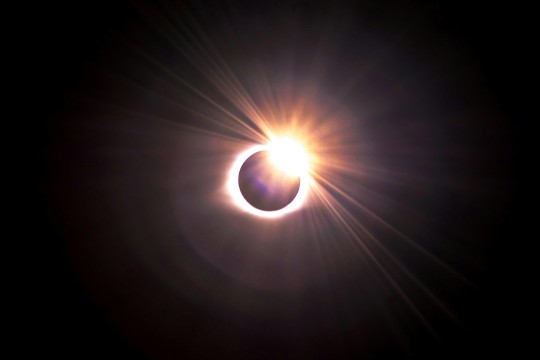News
Chester F. Carlson Center for Imaging Science
-
April 24, 2024
![a colorful 3 D image of the southern ring nebula appears in a black sky.]()
See the Southern Ring Nebula in 3D
Universe Today highlights the research led by Joel Kastner, professor in the Chester F. Carlson Center for Imaging Science, on the Southern Ring Nebula's dual-ring formation and the possible role of a second star.
-
April 15, 2024
![Stonehenge II, a concrete sculpture in Ingram TX is shown.]()
To each their own: In Texas town, reasons vary for watching eclipse
France 24 talks to Grover Swartzlander, professor in the Chester F. Carlson Center for Imaging Science, about viewing the recent eclipse from Stonehenge II in Texas.
-
April 10, 2024
![an image showing the earth from space in the background and tons of space debris floating around in the foreground.]()
RIT researcher helping Air Force investigate unresolved space objects
Satellites, rocket parts, and other space debris are clogging up the atmosphere with the potential to interfere with space-based assets, including items used for national security like GPS, weather, and communication satellites.
-
April 10, 2024
![a group of researchers gathers around a camera used to capture the eclipse.]()
University researchers measure the sun during the eclipse to assess impact on solar arrays
The recent total solar eclipse over Rochester provided a once-in-a-lifetime opportunity on Earth for two faculty-researchers and their students to capture data about the effects of the sun’s energy during a total eclipse.
-
April 8, 2024
![the sun is shown in a total eclipse]()
How will 2024 solar eclipse affect animals? What experts say
The Democrat and Chronicle speaks to Anthony Vodacek, professor in the Chester F. Carlson Center for Imaging Science, about his expectations of animal behavior during today's eclipse.
-
April 8, 2024
![a rock landslide is shown with a man taking a photo in the foreground and mountains in the background.]()
Researchers introduce new way to study, help prevent landslides
Landslides are one of the most destructive natural disasters on the planet, causing billions of dollars of damage and devastating loss of life every year. A global team of researchers has provided help for those who work to predict landslides and risk evaluations.
-
April 5, 2024
![Carl Salvaggio is shown sitting on a gray and orange chair with his arm resting casually on the top of the chair.]()
Imaging science professor continues legacy of his mentors
Life experience and lessons from all of his mentors, many of whom were past recipients of the Eisenhart Award, made Salvaggio a teacher worthy of the accolade.
-
April 2, 2024
![The Southern Ring Nebula, or NGC 3132, is shown through the lens of the James Webb Space Telescope.]()
Scientists release new insight about Southern Ring Nebula
Planetary nebulae have been studied for centuries, but astronomers are getting new looks and a better understanding of the structures and compositions of these gaseous remnants of dying stars thanks to the ability to study objects at multiple wavelengths and dimensions.
-
March 29, 2024
![Tony Vodacek is shown at his desk analyzing the sounds animals make on a computer.]()
RIT, Seneca Park Zoo team up to study animals’ reaction to Total Solar Eclipse
WROC-TV talks to Tony Vodacek, professor in the Chester F. Carlson Center for Imaging Science, about how he will analyze the sounds animals make during and after the eclipse.
-
March 27, 2024
![Tony Vodacek is shown talking to WHAM-TV sitting in front of his laptop that is displaying audio files.]()
How the April 8 total solar eclipse will affect animals
WHAM-TV talks to Tony Vodacek, professor in the Chester F. Carlson Center for Imaging Science, about his planned research on how the eclipse may provoke odd behavior in animals.
-
March 11, 2024
![the sun and moon are shown in total eclipse.]()
Solar eclipse could provoke some odd animal behavior at Seneca Park Zoo in Rochester
The Democrat and Chronicle talks to Anthony Vodacek, professor in the Chester F. Carlson Center for Imaging Science, about his planned observations.
-
February 22, 2024
![Serena Flint appears on screen with WHEC in a brown sweater]()
Cause of temporary AT&T service outage remains unclear
WHEC-TV talks to Serena Flint, research engineer in the Chester F. Carlson Center for Imaging Science, about solar flares.
















